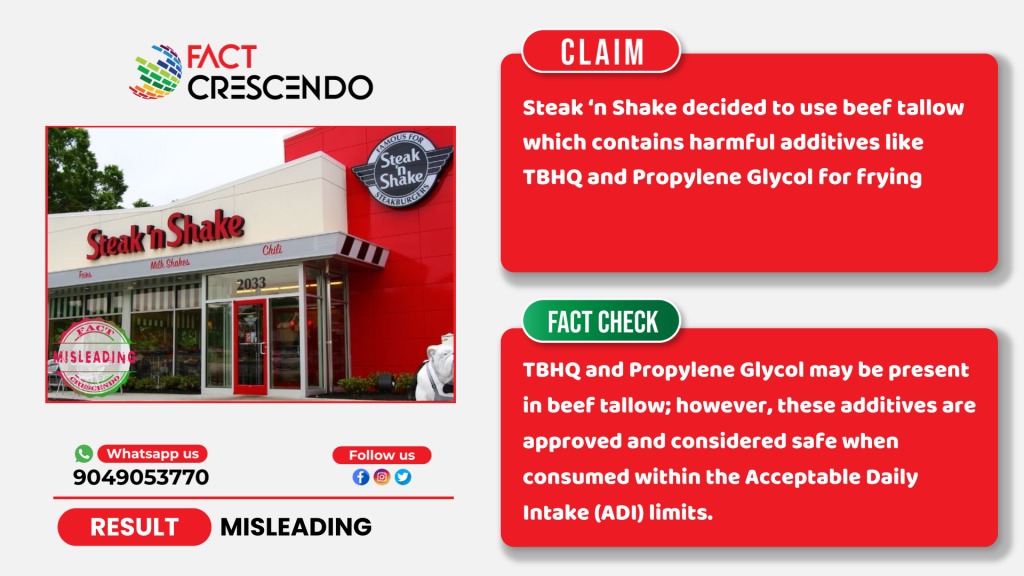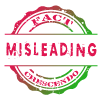
Steak ‘n Shake, a restaurant chain famous for its steakburger and shakes has come under scrutiny of the consumers after the company decided to switch to using beef tallow instead of seed and other oils for frying by February 2025.
Users raised their concerns claiming that Beef Tallow has harmful additives like TBHQ, Propylene Glycol, and Citric acid which are the reason for adverse health issues.
However, Fact Crescendo found the claim to be misleading. TBHQ and propylene glycol may be present in beef tallow but these additives are approved and considered as safe when consumed within Acceptable Daily Intake (ADI) value.
What’s the claim?
Social media users are claiming that this so-called beef tallow has TbHQ, Propylene glycol, And citric acid. TBHQ is cytotoxic, genotoxic, immunologic and neurotoxic. Propylene Glycol is a skin conditioning agent. It can cause seizures, lactic acidosis, comas, and hyperglycemia especially in children
Fact Check-
On 17 January 2025, Steak ‘n Shake tweeted that by the end of February 2025, all locations will use 100% all-natural beef tallow.
According to the Journal of Applied Pharmaceutical Science, pure beef tallow is rendered beef fat, composed of triglycerides, which include various fatty acids such as palmitic acid, stearic acid, and oleic acid. It is a natural product obtained by rendering the fat from cattle, particularly the fat surrounding the kidneys and loins. There may be other varieties of beef tallows which may have TBHQ and Propylene Glycol.
Is TBHQ approved?
The EFSA Panel studied the safety of TBHQ (E 319), a food additive allowed in the EU, with a safe daily limit of 0.7 mg per kilogram of body weight. Earlier studies showed that adults stayed within this limit, but there were concerns that consumption in infants might go over it. EFSA analyzed new data on how much TBHQ is used in foods and how much people actually consume. The results showed that, at maximum allowed levels, toddlers and children could exceed the safe limit. However, in more realistic scenarios, the safe limit was not exceeded for any group.
FDA approved TBHQ as a food additive and set specific conditions for its safe use. As per FDA, TBHQ must have a melting point of at least 126.5°C and be at least 99% pure. It should be used as an antioxidant, either alone or with BHA and BHT, to prevent oxidation in foods and the total amount of antioxidants, including TBHQ, in a food must not exceed 0.02% of the fat or oil content in the food.
According to the National Library of Medicine, TBHQ is a synthetic antioxidant and antimicrobial used in food, pharmaceutical, and cosmetic industries in approved amounts. It does not significantly accumulate in the body but can cause health issues, such as nutritional disorders, chronic diseases, and cancer, when consumed in high doses or over a long time.Therefore, it is recommended to strictly follow the usage limits in food. There are reports on therapeutic benefits of TBHQ under certain conditions but there is no clear data on how much TBHQ people can consume from all food sources. To minimize risks, it is recommended to use only approved amounts of TBHQ in food products.
Propylene Glycol:
According to the CDC, Propylene glycol is approved for use in food, cosmetics, and medicine at safe levels. Most people are exposed to it by eating, using skincare products, or taking medicine, but these small amounts are not harmful. Workers in industries using propylene glycol may touch or breathe it in, but exposure is usually low.
According to the National Library of Medicine, propylene glycol is a synthetic liquid that absorbs water and is used in many industries. It helps keep food, medicine, and cosmetics moist, acts as a solvent for flavors and colors, and is used as antifreeze when food contact is possible. The FDA considers it safe for use in food. It is also used to make polyester, deicing solutions, and artificial smoke for fire training and theater shows. It is a clear, colorless, slightly thick liquid with no strong smell or taste and only turns into vapor when heated or shaken. Other names for it include 1,2-propanediol and methyl glycol.
Conclusion:
Fact Crescendo found the claim to be misleading. The beef tallow used for frying by Steak ‘n Shake does not contain additives like TBHQ and Propylene Glycol. TBHQ and propylene glycol may be present in beef tallow but these additives are approved and considered as safe when consumed within Acceptable Daily Intake (ADI) value.
Update– Please note that the beef tallow used by Steak ‘n Shake is 100% natural and does not contain TBHQ and Propylene Glycol.

Title:Is Steak ‘n Shake’s Initiative to Use Beef Tallow for frying Safe or Full of Harmful Additives?
Fact Check By: Siddharth SahuResult: Misleading


